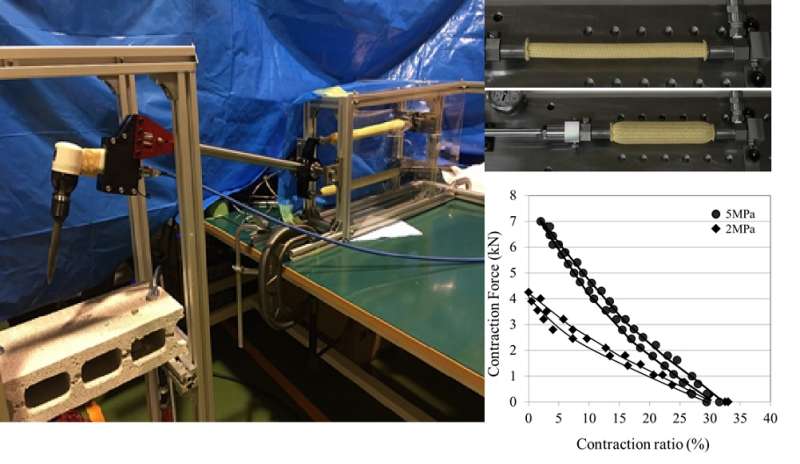Development of a hydraulic-driven, high-power artificial muscle

An artificial muscle using rubber tubing is extremely powerful but lightweight, with strong resistance to impact and vibration, allowing for the most compact and energy efficient tough robots ever created. Researchers expect that this will lead to the smallest, lightest, and most powerful consumer robots ever created in the near future.
Through the ImPACT Tough Robotics Challenge, engineers aim to create tough robots for rescuing people and ensuring safety in extreme environments after disasters like the Great East Japan Earthquake Disaster and Han-Shin Awaji Earthquake Disaster in Japan. When existing robots are used in disaster situations, a number of problems arise.
In this program, in order to create tough robots with excellent mobility and power that can be utilized for disaster recovery, the researchers are developing "tough hydraulic actuators," which are one of the key components. An actuator is a generic term for a device that generates motion and power and includes motors and cylinders. Most robots that currently exist are driven by electric motors that are based on technology commonly used for consumer products, but there are problems related to their structure. First, the strength-to-weight ratio (calculated by dividing the generated force by the weight of the actuator) is low (heavy and weak). Second, such robots have low resistance to outside impact and vibration; and third, it is difficult to achieve high power output while also producing gentle movement according to the situation.
To address these problems, the Tokyo Institute of Technology and Bridgestone have focused on the development of human-like muscles capable of outputting a large amount of power while also exhibiting flexible movement appropriate to the work being done. Since 2014, the researchers have been collaborating to promote research and development of highly powerful artificial muscles by striving for output greater than that possible by human muscles while also trying to reproduce their flexibility. These artificial muscles consist of rubber tubes and high-tensile fibers, and are actuated by hydraulic pressure. The use of these materials makes it possible to achieve smooth movement, and the use of hydraulic pressure yields a high strength-to-weight ratio, high shock and vibration resistance, and gentle movement appropriate for the work being done.
This research opens up new possibilities for creating robots that have greater toughness than current robots; are highly resistant to external shock and vibration; able to perform high intensity jobs; and to handle delicate jobs requiring precise power control as the situation necessitates.
The high-power artificial muscle that was successfully developed is a kind of McKibben-type artificial muscle. It consists of a rubber tube surrounded by a woven sleeve (many fibers woven into a cylindrical shape). Conventional McKibben-type artificial muscles operate at an air pressure of 0.3 to 0.6 MPa (nearly equal 3 to 6 kgf/cm2), but the artificial muscle developed by the researchers can be used in hydraulic pressure drives, and is operable at a pressure of 5 MPa (nearly equal to 50 kgf/cm2), which is much higher than conventional McKibben-type artificial muscles. Therefore, it is possible to generate a significantly higher amount of power with the muscle developed in this research.
The research team: (1) developed a new rubber material with excellent oil resistance and deformation characteristics; (2) adjusted the method for weaving the high-tension chemical fibers; and (3) worked to develop a technique for tightening tube ends that can resist high pressures. As a result, the researchers achieved an innovative, lightweight, and highly powerful artificial muscle with excellent pressure resistance and oil resistance capable of converting high hydraulic pressure into efficient power generation. It is an innovative actuator with a strength-to-weight ratio five to 10 times greater than conventional electric motors and hydraulic cylinders.
The researchers will continue to develop tough robots that use this artificial muscle in order to contribute to the spread of advanced robot services for a safe and secure society. In addition, they are aiming to achieve higher performance and to help spread its use and development as a consumer-use robot actuator.
Provided by Tokyo Institute of Technology



















